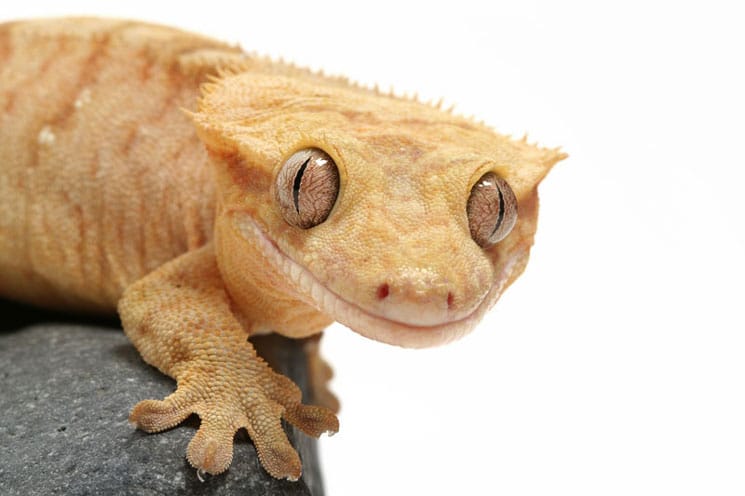Which one of these reptiles and amphibians is right for you?
Which one of these reptiles and amphibians is right for you?
In celebration of the 20th anniversary of Reptiles USA, we were asked to write an article describing the 20 most commonly kept, popular reptile and amphibian pets. While this is a rather subjective list, each of the animals described here are available in pet stores throughout the United States (and other countries). Naturally, the most common reptile species are also some of the most impressive, having gained notoriety for attaining large sizes, having an interesting or brightly colored pattern, or perhaps an interesting morphology or behavior. One has to take these things into consideration before purchasing one of these animals. Make sure you are prepared to provide appropriate accommodations, environmental parameters and proper diet for an adult of any species before deciding to purchase a cute baby. If these considerations are made before purchasing an animal, each of the species listed in this article can be rewarding captives, providing enjoyment for many years or even decades in some cases. So, in no particular order, here are some of the most-popular herps to be found.
AXOLOTL
(Ambystoma mexicanum)
Experience Level: Intermediate
The axolotl is a large, 12-inch long, aquatic salamander that once inhabited both Lake Chalco and Lake Xochimilco in the area of present day Mexico City. Unfortunately, Lake Chalco was drained due to issues with periodic flooding in the 1970s, and Lake Xochimilco exists only as a series of canals in and around the periphery of southern Mexico City. The axolotl is exceedingly rare in its native habitat, with only two confirmed specimens found in the last several years, but it is quite prevalent in captivity due to its use as a research subject for many decades.
The axolotl is often successfully kept in captivity, requiring a minimum aquarium size of 10 gallons per adult. A substrate of fine-grain sand or large-grade gravel (larger than the diameter of the head of the animals housed) should be selected, so as to minimize the risk of swallowing substrate. Aquarium furniture can include terra-cotta pottery that has been cut lengthwise to create artificial caves, real or artificial rock hides, real or artificial plants, and driftwood or other types of aquarium wood. Filtration is an important aspect of maintaining axolotls in captivity. Under-gravel filters, internal or external canister filters, or the type of filters that hang on the back of the aquarium can all be used successfully. The only problem with filters that hang on the back of the aquarium is that they can make it difficult to make the enclosure escape proof, and an ambitious axolotl could, potentially, escape from the aquarium and desiccate.
In selecting a canister filter, choose a capacity that is appropriate for the enclosure in order to avoid excessive aquarium turbulence (remember, axolotls occur in rather lentic water conditions in the wild). The water temperature should remain between 60 to 64 degrees Fahrenheit; temperatures in excess of 75 degrees will cause obvious stress in this species. Feeding axolotls is rather straightforward. Organic earthworms are an excellent staple for both adults and juveniles. Prepared trout or turtle pellets, live black worms, frozen or live bloodworms, Tubifex worms, Daphnia or brine shrimp can all be used to provide variety in the diet.
White’s tree frog is a solid amphibian, with adults measuring 3 to 4½ inches long. Females are larger than males. They live an average of 10 to 15 years, but the record is 21 years in captivity. Easy to maintain, one adult should be offered a vertical, 20-gallon enclosure. Add 5 to 10 gallons for each additional frog. A wide variety of substrates can be used effectively, including coco coir, New Zealand sphagnum moss, clean paper toweling or the Atlanta Botanical Garden soil mix, which has been broadly marketed in recent years due to it being long-lasting under moist conditions. Sturdy, broad-leaved plants should be provided to support these robust frogs. Branches should be included to facilitate climbing. A large water bowl should be filled with clean, dechlorinated water so that the frogs can soak in the evening and maintain their hydration status. Temperatures should be maintained at 70 to 85 degrees, with a 5- to 10-degree drop at night. Humidity should be maintained above 50 percent, with higher levels of roughly 80 percent achieved in the early evening by hand-misting the enclosure. Some keepers believe full-spectrum lighting is important for red-eyed tree frogs, and a fluorescent bulb with a 5-percent UVB spectrum is recommended. The diet consists primarily of appropriately sized insects, including crickets, waxworms or moths, and a variety of cockroach species marketed as feeders. Read the White’s treefrog care sheet.
CRANWELL’S HORNED FROG
(Ceratophrys cranwelli)
Experience Level: Beginner
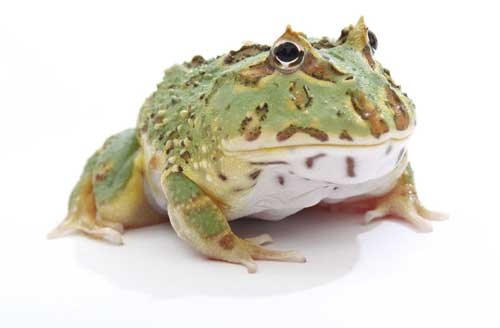
gina cioli/i-5 studio
The Pac Man frog is one of the more easily maintained frogs, as long as attention is paid to a few key details regarding care.
The Cranwell’s horned frog (a.k.a. Pac Man frog) is one of the most prominent frogs in herpetocultural history. It measures between 3 and 5 inches long, and may live up to 10 years in captivity. It is one of the more easily maintained frogs, as long as attention is paid to a few key details regarding care.
A 10-gallon terrarium or similar-sized plastic Sterilite or Rubbermaid bin should be considered the minimum enclosure size, with 5 to 10 gallons of space allocated per additional frog. Numerous substrates have been utilized in the care of horned frogs, including unbleached paper towels, foam rubber, coco coir, peat moss, large-grade aquarium gravel and even just shallow water. If using one of the organic substrate materials mentioned, a depth of 3 to 4 inches is ideal because these frogs will burrow when given the opportunity. It’s very important that the water and substrate be kept clean so as to avoid the accumulation of bacterial pathogens, as horned frogs are prone to Aeromonas and Pseudomonas infections (a.k.a. “red leg”). Clean, dechlorinated water should be provided in a shallow bowl at all times to maintain hydration.
Full-spectrum lighting is not typically required when keeping horned frogs because they are largely fossorial, but it may be needed if live plants are used in the design of the enclosure. It is important to provide a heat source, either an under-tank heating pad or an overhead ceramic heat emitter. The ambient temperature should be 70 to 80 degrees and the temperature of the basking site should be roughly 5 degrees warmer than the rest of the enclosure. Feeding horned frogs rarely presents a problem, given their voracious appetite and indiscriminate taste for anything they can fit into their large mouths. Earthworms and crickets should provide the staple diet, but occasional pinkie mice, feeder fish, and other insects can help to round out the diet. Read the Pac Man frog care sheet.
The red-eyed tree frog is one of the most famous amphibian species, owing its popularity to its tremendous beauty and interesting nocturnal behaviors. It can fare well in captivity, provided its basic needs are met. Adults measure 2 to 3 inches long, with females being larger, and they live anywhere from four to 10 years in captivity. A minimum enclosure size of 10 gallons should be considered appropriate for a red-eyed tree frog, with 5 gallons of additional space allocated per additional frog. A variety of substrates can be considered appropriate, including unbleached paper towels, moistened coconut coir or chunks, or the Atlanta Botanical Gardens soil mix available from a number of Internet retailers. A shallow, clean water source should be available at all times. Branches can be provided to allow for climbing; they maximize the space for these frogs that prefer to climb or walk as opposed to the more typical jumping behavior observed in most other anurans.
Real or artificial plants should be included to provide areas for the frogs to rest during the day. Potential live plant selections include broad-leafed species, such as Philodendron, Aglaonema or Dieffenbachia. The enclosure should be maintained between 77 to 80 degrees during the day, dropping into the low to mid-70s in the evening. A full-spectrum light with a low UVB rating should be provided for red-eyed tree frogs. It is important to provide appropriate humidity levels by either hand-misting the enclosure or purchasing an automatic misting system. The enclosure should be sprayed heavily in the early evening to promote normal activity. The relative humidity should approach 70 to 80 percent for a period of a few hours. Red-eyed tree frogs are insectivorous, with small cockroach species, crickets, wax moths and their larvae, and other small invertebrates all readily accepted.
ORIENTAL FIRE-BELLIED TOAD
(Bombina orientalis)
Experience Level: Beginner
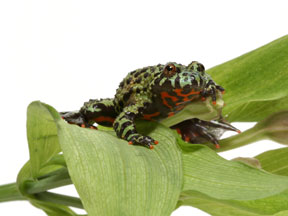
GINA CIOLI/I5 STUDIO
The Oriental fire-bellied toad measures approximately 2 inches long, with females being larger than males, and can live from 10 to 15 years.
The Oriental fire-bellied toad is another example of a beautiful anuran species that has long been a staple in the pet industry. It measures approximately 2 inches long, with females being larger than males, and can live from 10 to 15 years. A minimum enclosure size of 10 gallons should be considered appropriate for a fire-bellied toad, with 5 gallons of space allocated per additional frog. The enclosure should consist of both a terrestrial and aquatic section, in approximately a 50:50 ratio. Water quality is very important and should be maintained with either an appropriately sized internal canister filter or with daily partial water changes. The land section should consist of an appropriate soil mix, in which numerous live plants can be grown, including Scindapsus or Aglaonema species. Java fern or Java moss will do well in the aquatic section of the terrarium. The terrarium should be maintained between 65 to 75 degrees, and full-spectrum lighting with a low-UVB rating should be provided, as well. As with the other frogs discussed, its diet should consist of appropriately sized invertebrates.
CORN SNAKE
(Pantherophis guttata)
Experience Level: Beginner
The corn snake is easy to keep, and because of its calm demeanor and the many beautiful morphs that are available, it is one of the most popular snakes kept as a pet. Adults may reach 72 inches in length, and they can live up to 23 years.
Simple caging with minimal cage furniture works very well for a corn snake. A 15-gallon aquarium with an escape-proof lid is a good size for snakes 2 feet long and larger. Provide a hotspot of 85 to 90 degrees and a cool end to the enclosure that is around 75 degrees. A substrate of aspen shavings (avoid cedar shavings as they contain aromatic compounds), CareFresh, or even newspaper or paper towels can be used. A hide will provide comfort and ensure a better feeding response. Appropriately sized mice can be offered to corn snakes on a weekly basis; this translates to pink mice for baby corn snakes up to adult mice for corns that are 3 feet long or larger.
Captive-bred corn snakes have been available for more than 40 years, resulting in countless morphs. The authors have been working with one morph, the hypomelanistic form, for more than 24 years. Read the corn snake care sheet.
CALIFORNIA KINGSNAKE
(Lampropeltis getula californiae)
Experience Level: Beginner
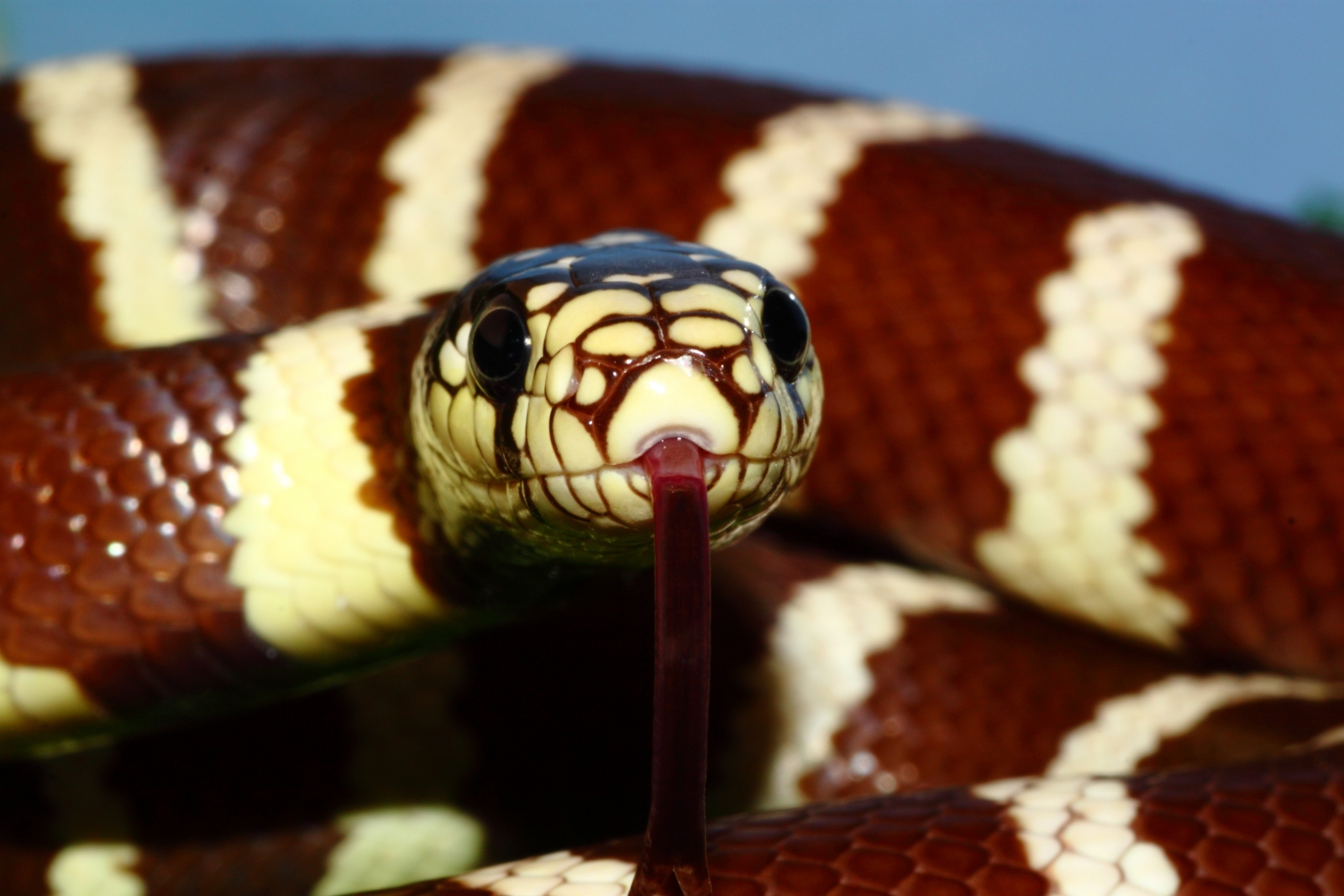
shutterstock/mattiaath
California kingsnakes can live at least 20 years.
Like the corn snake, the California kingsnake is an easy-to-keep colubrid. It has a calm demeanor, readily feeds on rodents and doesn’t attain a large size. Adults may attain 6 feet, but usually average between 3 and 4 feet long. California kingsnakes can live at least 20 years, and a huge variety of interesting morphs are readily available.
A California kingsnake will do well in a 15-gallon aquarium with an escape-proof lid, a hotspot between 85 and 90 degrees and a cool end of 75 degrees.
Substrates such as newsprint, paper towels, CareFresh, and aspen shavings work very well for this species; they provide places for hiding and are absorbent when snakes defecate. Newsprint needs to be replaced more frequently than the others, but all should be changed at least bimonthly.
Hide areas large enough for the snake to coil beneath in its entirety are very much appreciated and will encourage California kingsnakes to feel safe enough to feed more readily. Mice, ranging from pink mice for neonate kingsnakes to adult mice for adult animals, should be offered three to four times a month to maintain proper body weight. Read the California kingsnake care sheet.
ROSY BOA
(Lichanura trivirgata)
Experience Level: Intermediate
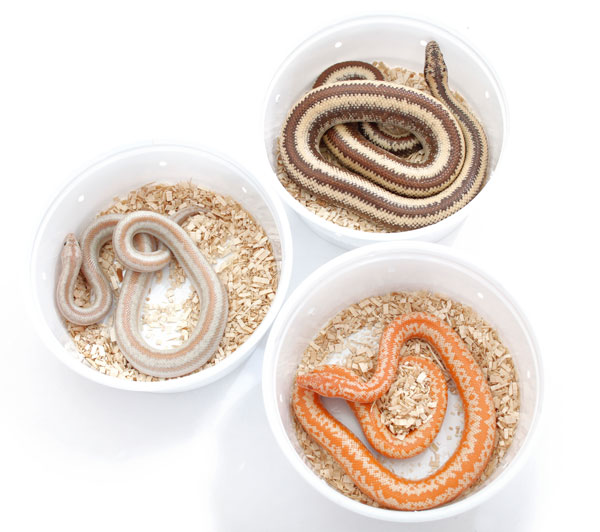
GINA CIOLI/I-5 STUDIO. SNAKES COURTESY RANDY WRIGHT
Rosy boas also come in a wide array of colors, including several amelanistic and melanistic forms.
This small boid rarely grows larger than 3 feet, but it is a long-lived snake, commonly living for 20 years in captivity, and possibility 50-plus years. So be sure you can offer that level of commitment before obtaining a rosy boa. Rosy boas also come in a wide array of colors, including several amelanistic and melanistic forms.
Rosy boas feed on mice of various sizes, depending upon the size of the snake. They have very simple caging requirements. Most will do very well in a 10- or 15-gallon aquarium with an escape-proof lid. An absorbent substrate, such as pine shavings, newspaper or CareFresh, works well with rosy boas. Provide a temperature gradient in the enclosure, with a hot spot between 85 and 90 degrees at one end and a cooler temperature of about 75 degrees at the other end.
Because of their secretive nature, rosy boas will utilize a hide area they can comfortably coil beneath, which may make their feeding response even better. Some rosy boas have such a tremendous feeding response that they may “bite the hand that feeds them” by mistake, so care should be exercised before handling your pet. Use an inanimate object, such as a snake hook or paper towel roll, to first touch the snake and let it know it is not being fed at that moment. Usually, once a rosy boa is in hand, it rarely bites (interestingly, rosy boas never seem to bite when first encountered in the field; it is only under captive conditions that they acquire a strong feeding response). Read the rosy boa care sheet.
BALL PYTHON
(Python regius)
Experience Level: Intermediate
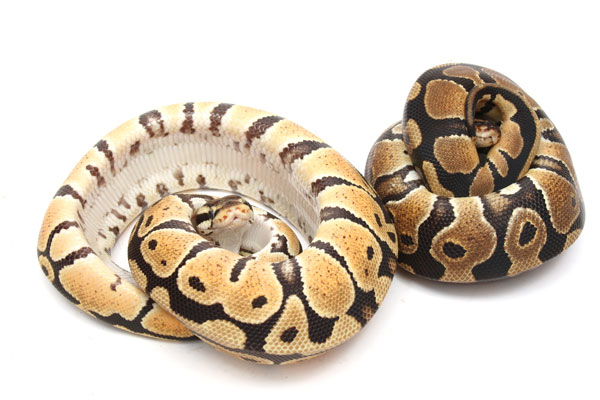
GINA CIOLI/I-5 STUDIO
Ball pythons require a very humid environment, and they will need to be sprayed daily with water to maintain humidity levels between 55 and 65 percent.
For those desiring a larger boid than a rosy boa, the ball python may fit the bill. Beautiful and docile, the ball python is very popular in herpetoculture. Specimens do not attain a huge size (usually less than 50 inches) and have a calm demeanor. They commonly live between 20 and 30 years, but the record so far is 48 years. Most readily feed on mice and rats.
Enclosure size depends upon the size of the snake. Young ball pythons do well in 10-gallon aquariums. Adult snakes will need at least a 40-gallon, escape-proof enclosure. Because of their shy nature, a hide area they can comfortably coil beneath is recommended for ball pythons. Substrates that work well include newsprint, aspen shavings, cypress mulch and pine shavings.
Ball pythons require a very humid environment, and they will need to be sprayed daily with water to maintain humidity levels between 55 and 65 percent. Keeping a large water bowl in a ball python’s enclosure will also help maintain proper humidity levels. Higher humidity levels help keep ball pythons healthy, especially during the shedding process.
Offer a hotspot of 85 to 90 degrees and a cool end of 75 degrees. No artificial lighting is necessary.
Most ball pythons can live their entire lives on a diet of mice. However, some breeders prefer to feed ball pythons rats once they are large enough to eat them. A food item once weekly is sufficient for maintaining proper body weight.
Sometimes ball pythons refuse to eat during the winter. This problem is ameliorated during the spring when the feeding response picks up. If the animal is maintaining sufficient weight, this is probably not a problem. If it repeatedly refuses food, a hide area may help improve the situation. If the ball python is young, the feeding response is usually very strong.
There are many beautiful ball python morphs available. These include spiders, amelanistics, clowns and many others. Because they are easily bred in captivity, ball pythons are readily available at reptile specialty shops, online and at reptile shows. Read the ball python care sheet.
BOA CONSTRICTOR
(Boa constrictor)
Experience Level: Advanced
For those who want to work with a large snake, the boa constrictor is one of the better choices. In some cases, adults can reach up to 13 feet long. They usually live between 20 to 30 years in captivity, but in rare cases they have lived as long as 40 years. Captive-bred individuals are very tractable when compared to wild-caught animals, so an effort should be made to purchase captive-bred specimens whenever possible. Boa constrictors are readily available and there are many interesting morphs available. Of major concern keeping large boids, however, are new laws prohibiting the captive maintenance of these snakes in some areas. Make sure you are not going to be in violation of any city or state laws before purchasing a large constrictor.
Because of their large size, a large enclosure is an absolute must. Young boa constrictors can be maintained in a 20-gallon aquarium with an escape-proof lid. Given their large size, adults will need a much larger enclosure. An average of 48 inches long, 24 inches wide and 18 inches tall is appropriate for an adult boa, but larger individuals will require an enclosure that’s up to 96 inches in length. Absorbent bedding is a necessity because boa constrictors, especially large ones, produce a large volume of feces. Newspaper, pre-cut paper cage liners, aspen bedding and cypress mulch are appropriate substrate choices.
A clean water dish large enough for the boa to completely submerge its body should be provided at all times to allow the snake to drink and also to help maintain humidity between 40 and 50 percent. The ambient temperature in the enclosure should be maintained between 78 and 88 degrees, and the basking site should be 90 degrees. An under-tank heating pad controlled by a thermostat is the safest and easiest way to maintain the temperature within a boa enclosure.
Feeding boa constrictors is rarely a problem. Small or young specimens will do well on a diet of appropriately sized rats (an “appropriately sized” food item is one that would cause a slight bulge in the snake). It is rare that a food item larger than an adult rat would be needed, but larger boa constrictors may require larger rodents (such as guinea pigs) or rabbits. Read the boa constrictor care sheet.
LEOPARD GECKO
(Eublepharis macularius)
Experience Level: Beginner
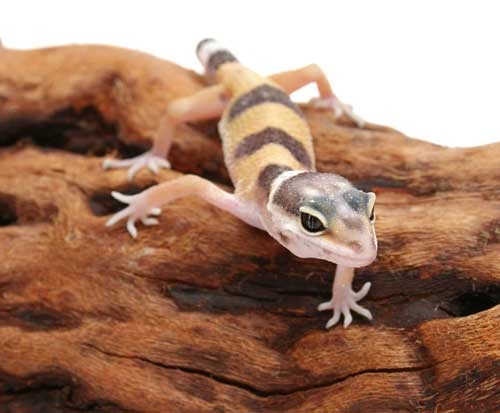
PHOTO CREDIT: GINA CIOLI/I-5 STUDIO
Small, easy to handle and beautiful, the leopard gecko is a well-deserving addition to our list of the 20 top herps.
Small, easy to handle and beautiful, the leopard gecko is a well-deserving addition to our list of the 20 top herps. Leopard geckos are readily available in a wide array of colors and patterns. They are very long-lived lizards, averaging 15 to 20 years. Females measure between 7 and 8 inches long, and males 8 and 10 inches.
Caging can be very simple: a 10-gallon aquarium with a secure lid can house an adult leopard gecko. Reptile carpet works well as a substrate. DO NOT USE SAND, as they can ingest it while feeding and that can cause impaction. They’re nocturnal, so UVB lights are unnecessary. Leopard geckos should have access to temperatures up to 90 degrees on the warm side of their enclosure. The easiest way to provide this is by using a heat mat, heat tape, etc., at one end of the cage. A thermostat designed for reptile cages works well to monitor temperatures and make sure the temperature of the basking area does not climb higher than 90 degrees. Ambient air temperature should be maintained between 73 and 80 degrees. Provide a humid hide, maintained at 70- to 80-percent humidity, to aid with shedding. This can be a plastic container with a hole cut in the lid, containing moistened coco coir, kept in the warmer portion of the cage. The substrate in the remainder of the cage should be kept dry, and the relative humidity should remain under 60 percent. A water bowl with fresh, dechlorinated water should be provided at all times; do not allow the bowl to spill onto the surrounding substrate.
Leopard geckos are insectivorous and readily eat any appropriately sized insect, including crickets, cockroaches and mealworms. All feeder insects should be gut-loaded and dusted with a vitamin and mineral supplement. Green leafy lettuce, orange slices and dry dog food or powdered rodent block are a good mix for gut-loading the insects before offering them to your lizard. Simply place these foods in with the insects 24 hours before offering the insects to your leopard gecko. Read the leopard gecko care sheet.
BEARDED DRAGON
(Pogona vitticeps)
Experience Level: Intermediate
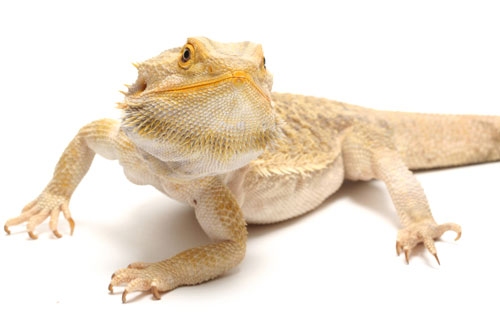
GINA CIOLI/I5 STUDIO
The bearded dragon is widely captive bred.
Bearded dragons make incredible pets. They are prehistoric in appearance and grow quite large—up to 24 inches long—and they live between seven and 10 years on average. They often become very docile in captivity.
Because of their size, a large enclosure is beneficial. In general, a 40-gallon enclosure is the bare minimum for an adult pair of these lizards. A larger enclosure is preferable.
Offering them food in a dish works well. We use millet seed as a substrate for our beardies. If accidentally ingested, the millet is easily digested with no problems.
Feeding bearded dragons rarely presents any difficulties. They are omnivorous and will eat crickets, mealworms, green leafy vegetables, grated carrots, grapes, etc. A well-balanced diet is important and, like leopard geckos, bearded dragons will benefit from invertebrate prey items that have been gut-loaded and dusted with a vitamin/mineral supplement.
Given that bearded dragons are diurnal, they need light that provides ultraviolet radiation (UVB). Our colony lives outdoors during the warmer months, which provides ample exposure to ultraviolet radiation. If kept indoors, artificial UV lighting is necessary to prevent metabolic bone disease. Temperatures should range from a low of 75 to 85 degrees to highs of up to 110 degrees under the basking spot; use an incandescent light specifically designed for reptiles to attain these high temperatures. Place the light at one end of the cage, allowing the lizard a range of temperatures from which to choose, from the hot end to the cooler end. Humidity should be low, between 25 and 40 percent, and the walls of the enclosure should be lightly misted every three to four days. Soak your dragons once a week to keep them hydrated.
There are many interesting morphs available, from bright red-orange, to scaleless, to hypomelanistic, etc. Of course, some of the more exotic forms can cost a lot of money. Given that bearded dragons are so readily bred under captive conditions, most pet stores have them available for purchase. The normal color phases are usually inexpensive and make a fantastic first lizard for the novice keeper. Read the bearded dragon care sheet.
SAVANNAH MONITOR
(Varanus exanthematicus)
Experience Level: Intermediate
The savannah monitor has a large distribution in sub-Saharan Africa, from Senegal east to Sudan and through portions of the Democratic Republic of the Congo in the south. Savannah monitors inhabit semi-arid grasslands and open woodland areas. They primarily live in burrows and other terrestrial environments, but they can climb to modest heights in search of food. The species attains an average length of 3½ to 5 feet in captivity, with females typically only slightly smaller than males. Savannah monitors live between 10 and 15 years.
An enclosure measuring 6 feet long, 2 feet wide and 5 feet tall should be considered the minimum size for an adult monitor. Substrate of equal parts sand and soil should be used. Some keepers advocate a depth of up to 2 feet to facilitate burrowing. Full-spectrum lighting in the form of a mercury vapor bulb is advocated for this species, given their affinity for high-temperature basking sites. The ambient temperature should be roughly 80 degrees, with the warmer side of the enclosure reaching 90 degrees. The basking site should consist of a branch or similar feature directly beneath the mercury vapor bulb. A minimum of 100 degrees should be the goal, with some keepers reporting temperatures as high as 130 degrees being tolerated by these animals. A large, clean water source large enough for your monitor to soak in should be available at all times to help maintain adequate humidity levels and allow your pet to drink. An ambient humidity of 60 percent is recommended, with higher humidity levels available within the burrow.
This is an opportunistic predator, feeding on a large variety of both vertebrate and invertebrate prey. Young lizards can be fed gut-loaded crickets, mealworms, cockroaches, night crawlers and occasionally waxworms. Adults should still receive a large percentage of invertebrate prey. Savannahs will readily consume night crawlers and large roach species, such as Madagascan hissing cockroaches. Avoid too many rodents, as they are high in fat and can contribute to obesity if fed in excess. No more than one rodent a week should be offered to an adult savannah monitor. Read five savannah monitor care tips.
CRESTED GECKO
(Correlophus ciliatus)
Experience Level: Intermediate
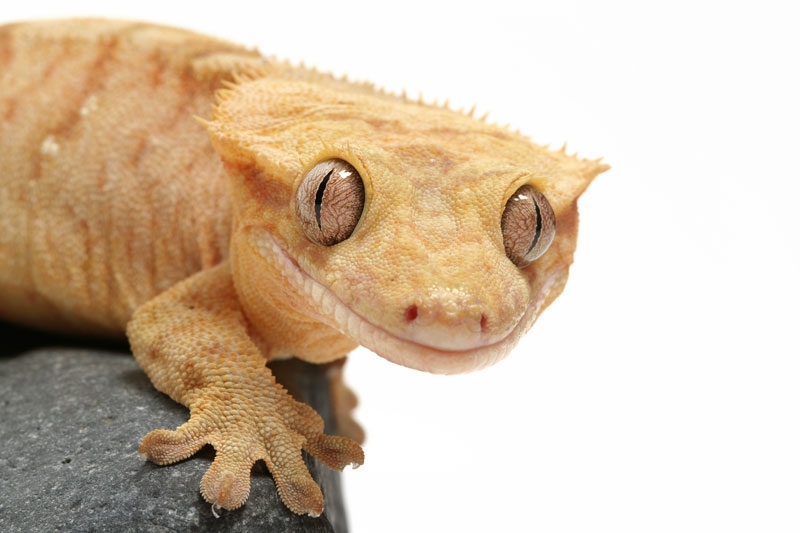
GINA CIOLI/I5 STUDIO
Pet crested geckos require a modest terrarium size, with 20 gallons being considered the minimum for one adult gecko.
The crested gecko is a medium-sized gecko (4 to 4½ inches snout-to-vent length, 8 inches total length) from southern New Caledonia, with one population on the Isle of Pines and surrounding islets, and two populations on the main island, Grand Terre. Its life span is between 15 and 20 years. Its wild habitat consists of tropical forest that receives high annual rainfall, where it spends the majority of the day hiding in dense vegetation. Actively foraging in the lower levels of the canopy at night, crested geckos rarely ascend to a height greater than 10 feet from the forest floor.
Pet crested geckos require a modest terrarium size, with 20 gallons being considered the minimum for one adult gecko. Approximately 10 gallons of terrarium space should be added per additional gecko. Enclosures can be either screen or glass, depending on ambient humidity levels. The temperature should range between 72 to 80 degrees, with a 5- to 7-degree drop at night. Humidity should be maintained at levels above 50 percent, with higher levels (80 to 100 percent) provided via daily misting in the early evening. The enclosure should include numerous branches, cork tubes and broad-leafed live or artificial plants; cork tubes provide excellent hides. As with other nocturnal geckos, UVB lighting is not thought to be necessary, but fluorescent lighting should be provided if live plants are used. Ambient or direct lighting should be available for an average of 12 hours each day.
Commercial diets are sold for crested geckos, such as those produced by Repashy Superfoods. These can either be fed exclusively, or mixed with feeder insects, such as roaches or crickets. Read the crested gecko care sheet.
VEILED CHAMELEON
(Chamaeleo calyptratus)
Experience Level: Intermediate
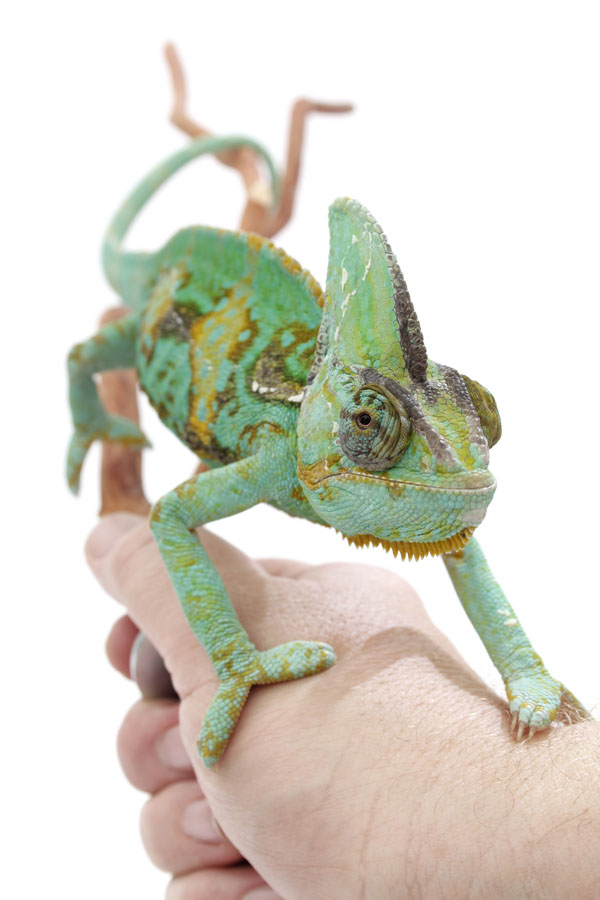
Gina CIOLI/I5 STUDIO
Veiled chameleons will eat gut-loaded crickets, cockroaches, mealworms, waxworms, silkworms or tomato hornworms.
The veiled chameleon inhabits coastal mountain slopes of Yemen and Saudi Arabia. These areas receive modest amounts of annual rainfall, and dew will accumulate on the vegetation in the early morning hours, but this is a rather arid-adapted chameleon species. Males can be quite large, attaining lengths of up to 2 feet. They can be recognized by the tall casque on their heads. Females attain lengths of approximately 18 inches and have a comparatively less obvious casque. They live five to eight years.
As with most chameleon species, a screen enclosure is typically viewed as ideal, as this type of enclosure provides adequate air circulation and reduces the risk of respiratory infection. An enclosure size of 24 inches long, 24 inches wide and 48 inches tall should be considered the minimum for an adult male, with adult females able to tolerate slightly smaller enclosures. A variety of small-diameter branches should be placed within the enclosure to facilitate foraging and basking behavior. Live or artificial plants can be provided so your chameleon can drink off the leaves after misting. Pothos plants seem to tolerate the higher temps needed by veiled chameleons, and they will provide an attractive accent to the enclosure. No substrate should be used due to the risk of impaction.
An ambient temperature of 72 to 80 degrees is considered ideal for veiled chameleons, with a basking site of 95 degrees being provided in the upper reaches of the enclosure. High-output UVB lighting in the form of a mercury vapor bulb or 10-percent UVB strip light should be provided at a distance of 6 to 8 inches from the basking site. This promotes vitamin D synthesis and appropriate calcium metabolism. If a strip light is provided as the UVB source, a separate heat source will also need to be provided, such as a basking bulb or ceramic heat emitter. Mercury vapor bulbs provide both heat and UVB light.
Veiled chameleons will eat gut-loaded crickets, cockroaches, mealworms, waxworms, silkworms or tomato hornworms. Juveniles should be fed daily. Adult veiled chameleons can be fed three to four times weekly. Dust their crickets with a calcium supplement at every other feeding and a multivitamin supplement biweekly. Read the veiled chameleon care sheet.
RED-FOOTED TORTOISE
(Chelonoidis carbonaria)
Experience Level: Intermediate
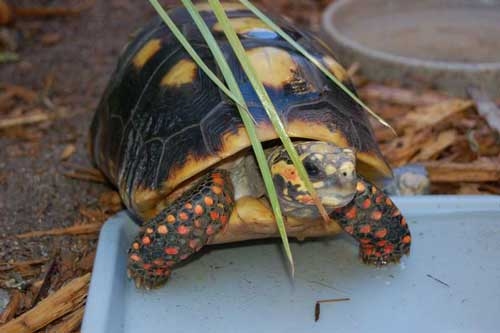
TYLER STEWART
The red-footed tortoise is a wonderful first tortoise for a beginner tortoise enthusiast.
The red-footed tortoise is a wonderful first tortoise for a beginner tortoise enthusiast. Its inherent beauty and small size (10 to 14 inches total carapace length) make it an excellent candidate for a pet.
The red-footed tortoise has a domed carapace and a narrow shell when compared to other chelonians. Like most tortoises, it is a long-lived animal, with a life span up to approximately 50 years. There are several different morphs. The “cherry-headed” red-footed tortoise is a beautiful race with bright-red coloration on the head and limbs. This morph is typically smaller than other races, measuring 10 to 12 inches in total length. Males are easily distinguished from females by the concave plastron and longer tail.
When outdoor temperatures are above 70 degrees, red-footed tortoises should be kept outdoors in an escape-proof and heavily planted enclosure. It should be watered daily in order to provide sufficient humidity and shade from the sun during the warmer months. Dense grasses (e.g., Muhlenbergia spp.) are an excellent choice for planting in an outdoor red-footed tortoise enclosure, as they are edible and will provide shade during the warmer parts of the day.
Fresh water should be provided in a large, shallow bowl so the tortoises can drink and maintain hydration. Because of their tropical origins, red-footed tortoises do not require a period of brumation. In the cooler fall and winter months, they should be maintained indoors, where the temperature can be carefully monitored and not fall below 70 degrees. This will prevent red-footed tortoises from becoming sick with ailments such as an upper respiratory infection.
Providing a large enclosure helps to establish an appropriate temperature gradient. Our juvenile, 6-inch red-footed tortoise is maintained in a large display cage measuring 36 inches long, 18 inches wide and 12 inches tall, with UV lighting and an infrared bulb for maintaining warm temperatures. For babies, an appropriate enclosure would be a 10-gallon aquarium. For a pair of adults, an enclosure that measures 10 feet long, 10 feet wide and 2 to 3 feet tall works well. Add another 5 square feet for each additional tortoise. Never house two males together, as they will fight.
Red-footed tortoises should be fed daily. They will eat a variety of vegetables, including kale, collard greens, dandelion greens, mustard greens, bok choy, endive and alfalfa. Two to three times a week, they will also enjoy fruits, such as bananas, strawberries, oranges and pears. Read the red-footed tortoise care sheet.
RED-EARED SLIDER
(Trachemys scripta)
Experience Level: Beginner
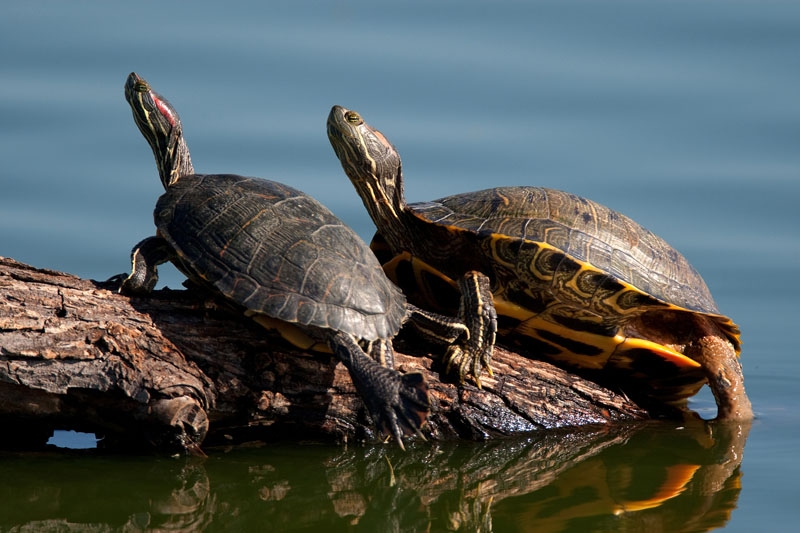
SHUTTERSTOCK/LAURIE L. SNIDOW/
The red-eared slider is perhaps the most commonly kept chelonian, but unfortunately, this beautiful turtle rarely receives the proper care it deserves.
The red-eared slider is perhaps the most commonly kept chelonian, but unfortunately, this beautiful turtle rarely receives the proper care it deserves. Before obtaining one, know that adults can grow to be quite large and they will need to be provided with ample space in order to fulfill their basic requirements.
Male red-ears are typically 7 to 9 inches as adults, and females are roughly 10 to 12 inches, with some larger individuals reported. They can live up to 40 years.
A 125-gallon aquarium should be considered the minimum size for an adult turtle, with roughly 15 gallons of additional space allocated per additional turtle. Aquariums, molded plastic tanks (e.g., Waterland tubs or stock tanks) or an outdoor pond can all be used to house red-eared sliders.
Filtration is a key aspect of caring for this species in captivity. An internal canister filter is adequate for hatchling turtles, but a high-quality external canister filter will be needed to maintain water quality for adults. Water temperatures should be maintained at 72 to 76 degrees for adults, and roughly 78 to 80 degrees for hatchlings. A dry basking site with a temperature of 88 to 92 degrees should be provided in order to promote appropriate digestion and other metabolic processes.
Juvenile red-eared sliders should be fed a primarily carnivorous diet of pelleted turtle foods, earthworms, live or frozen bloodworms, blackworms or other insects. They will also accept a variety of dark, leafy green vegetables (including kale, mustard and dandelion greens, beet leaves and endive). Red-ears should be transitioned to an increasingly herbivorous diet throughout their lives, taking care to provide a balanced diet with an appropriately conservative protein content that will ensure proper growth rates and shell health. Read the red-eared slider care sheet.
LEOPARD TORTOISE
(Stigmochelys pardalis)
Experience Level: Intermediate
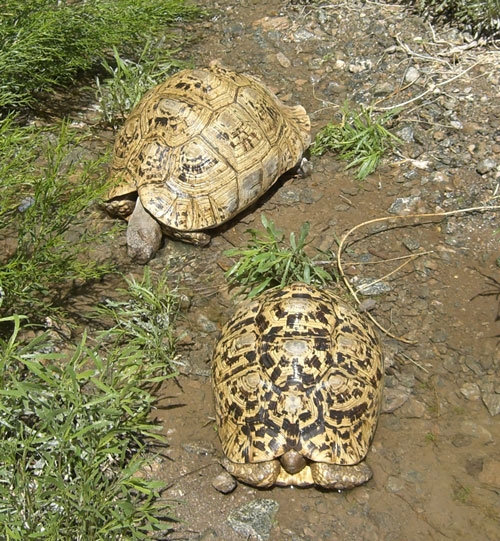
JERRY D. FIFE
Leopard tortoises should be kept in outdoor pens. A pair can be housed in an enclosure with roughly 100 square feet of available space.
Two subspecies of the leopard tortoise are commonly recognized: Stigmochelys paradlis pardalis from southwestern Africa (South Africa and Namibia) and S. p. babckocki from eastern and southern Africa. The latter is the more commonly encountered race, given its larger distribution. There is a lot of variability in the leopard tortoise’s size, with adult specimens averaging from 10 to 18 inches. Stigmochelys p. pardalis is larger on average, with some specimens attaining a length of 24 inches. Individuals of both subspecies can live between 50 and 100 years.
Ideally, leopard tortoises should be kept in outdoor pens. A pair can be housed in an enclosure with roughly 100 square feet of available space. The walls should be 18 inches tall and solid to allow the tortoises to feel secure. The pen should be planted with a variety of shrubs and bunch grasses, also to provide security. Leopard tortoises don’t burrow, so ample shade must be provided when keeping them in warmer climates.
If the climate where you live would not permit you to house a leopard tortoise outdoors year-round, an indoor enclosure, such as a large stock tank, can be utilized. Fresh grass hay or cypress mulch can be used as substrate for indoor tortoises.
Regardless of climate, juvenile tortoises are often raised indoors to better monitor food intake and growth, as well as to prevent predation. Hide areas with higher humidity should be provided in order to prevent desiccation, and also to promote proper shell growth. Too dry of an environment, along with a calcium-deficient diet, is thought to contribute to “pyramiding” of the shell.
If leopard tortoises are maintained outdoors, it will be necessary to provide supplemental heat on nights that dip below 60 degrees. This can achieved using a ceramic heat emitter or a “pig blanket” that is regulated by a thermostat. Some keepers also opt to bring their tortoises inside on colder nights.
For juvenile tortoises and others housed indoors, high-output UVB lighting is mandatory. A mercury vapor bulb provides both heat and an appropriate light spectrum, and this is the easiest way to ensure appropriate temperatures and UVB levels. The indoor enclosure should be maintained between 75 and 90 degrees, with a basking site of 95 degrees.
Grasses should form the bulk of the leopard tortoise diet. These can be supplemented with dark, leafy greens (collard, dandelion or mustard), hibiscus leaves or flowers, spineless cactus pads, carrots, zucchini or yellow squash. Fruits can be an occasional treat, but they should not constitute more than 5 percent of the diet. A clean, shallow water dish should be provided at all times in order to promote drinking and avoid dehydration. Read the leopard tortoise care sheet.
EASTERN BOX TURTLE
(Terrapene carolina)
Experience Level: Beginner
Eastern box turtles are small, ranging between 4½ and 6 inches long, though some have reached 7 or 8 inches. They are long-lived; in the wild, they have been rumored to live 80 to 100 years. So be sure you can make the commitment before obtaining one.
As with other chelonians, eastern box turtles are ideally maintained outdoors. The enclosure should provide a minimum of roughly 25 square feet of space for a pair of turtles, but this is a rough guideline and must be adjusted based on temperature extremes of the keeper’s yard space. A bottom barrier should be included in the design of the enclosure, typically chicken wire or hardware cloth that is buried to a minimum depth of 8 to 10 inches. A roof constructed of hardware cloth or chicken wire should be constructed to prevent predation or injury by wild and domestic animals.
A variety of grasses should be planted to provide shade within the enclosure. In warmer environments, it may also be necessary to have shade trees in the vicinity to further buffer the temperature. Hide areas should also be provided, such as hollow logs or terra-cotta pottery that has been cut lengthwise and then partially buried in the soil. A clean, shallow water dish is necessary to prevent dehydration.
Very young hatchlings or sick box turtles will need to be maintained indoors. A 40-gallon aquarium will provide sufficient space for a temperature gradient that will allow the turtles to properly regulate their body temperatures. A medium-output UVB source will facilitate proper vitamin D synthesis and calcium metabolism. A basking site of 90 to 95 degrees should be provided using a heat light or ceramic heat emitter.
Box turtles are omnivorous, consuming a slightly larger volume of insect prey than plant material. Appropriate insect prey include earthworms, crickets, small cockroach species and, occasionally, waxworms and mealworms. Plant material should include dark leafy green vegetables (collard, mustard and dandelion greens, and kale), shredded squashes and occasional berries as a treat. Read the Eastern box turtle care sheet.
RUSSIAN TORTOISE
(Agrionemys horsfieldii)
Experience Level: Beginner
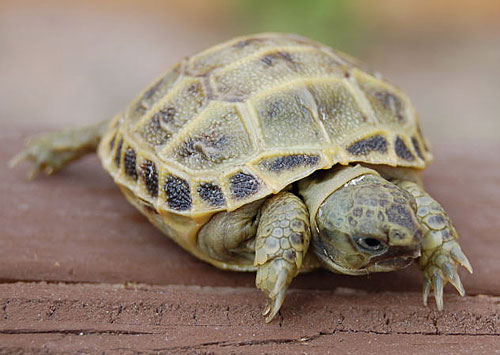
tyler stewart
Russian tortoise hatchling.
The Russian tortoise is one of the more commonly kept chelonians. Its endearing personality and relatively small size makes it another good choice as a first tortoise pet. Wild Russian tortoises inhabit harsh, semi-arid environments in Afghanistan, China, Iran, Pakistan and Russia.
The Russian tortoise grows to approximately 6½ to 8 inches, with females attaining slightly larger sizes. It is best housed outdoors, with a minimum enclosure of approximately 25 square feet per tortoise. Again, a larger environment will be needed in more harsh environments in order to buffer temperature extremes. The enclosure should be similar to that of the eastern box turtle, in that the tortoises should not be able to dig out, and predators should not be able to jump into the enclosure to harass or injure the animals housed within.
A sandy soil should be provided in order to provide proper drainage and prevent stagnation of the soil. The enclosure should be planted with a variety of bunch grasses to provide hide areas and break up the line of sight. Rocks, logs and similar furnishings should be included to provide shade and allow the tortoises to hide within the enclosure. A large, clean water dish should be available at all times to allow the tortoises to hydrate as needed.
Juvenile and ill tortoises may need to be housed indoors. If this is the case, provide the largest enclosure possible. A large stock tank or similar molded plastic container can be used, along with a substrate of clean, fresh grass hay or cypress mulch.
Russian tortoises require high levels of UVB, and mercury vapor bulbs are the easiest way to provide this in the indoor environment, as they provide both heat and UVB radiation. It is also possible to use a high-output strip light (10-percent UVB) in addition to a heat light or ceramic heat emitter to provide the basking site. The ambient temperature within the indoor enclosure should be 70 degrees, with approximately a 10-degree drop in temperature overnight. The basking site should be approximately 95 degrees.
As with other chelonians, diet is the most often overlooked aspect of captive maintenance of this tortoise. Russian tortoises are herbivorous, grazing on a variety of grasses in their natural environment. Grasses, therefore, should comprise the majority of a pet Russian tortoise’s diet. Additional items can include dark leafy greens (collard, dandelion and mustard greens, as well as kale), escarole, spineless Opuntia cactus pads, hibiscus flowers or leaves, and native wildflowers. It is also advisable to use a calcium supplement when feeding young Russian tortoises, to facilitate proper shell growth. Read the Russian tortoise care sheet.
Choose Wisely
Choosing a new reptile or amphibian to keep as a pet can be an exciting experience. Once you have selected an animal, do some more research into their needs. REPTILES magazine and Reptiles USA have published in-depth articles on every reptile and amphibian discussed in this article; take the time to look up that information on ReptilesMagazine.com or in the printed magazine, and make a wise choice. Remember, many of these animals are extremely long-lived, and you will have to live with your decision for many years to come!
Gerold Merker has a bachelor’s degree in zoology from the University of California, Davis, and a master’s in biology from U.C. Riverside. A teacher and photographer, he has authored or co-authored numerous reptile and amphibian articles.
Walter Merker graduated from the University of California at Davis School of Veterinary Medicine. He is a veterinarian at a small and exotic animal practice in Henderson, Nev. His diverse collection of reptiles and amphibians focuses on North American desert lizards and Latin American hylid frogs. He has coauthored numerous articles and one book, Alterna: The Gray-Banded Kingsnake, with his father, Gerold.

